<b>Aquatic microbiota diversity in the culture of Nile tilapia (<i>Oreochromis niloticus</i>) using bioflocs or periphyton: virulence factors and biofilm formation
Resumo
The following research isolated and identified the main bacterial groups present in the culture of juvenile Nile tilapia in the presence of bioflocs and/or periphyton. The strains were also tested for the production of exoenzymes, indicative of potential virulence factors, and ability to form biofilm. The water samples were taken from tilapia cultured in the presence of bioflocs (T1), in the presence of bioflocs and periphyton (T2), from traditional culture (T3) and from culture in the presence of periphyton (T4). In the growth and selection of the bacterial groups, pour plate method was used, along with the following media: Plate Count Agar (PCA - DIFCO), Aero Pseudo Selective Agar (GSP - Himedia) and Nutrient Agar (AN - Merck). 46 strains were isolated in the following distribution: T1 (n = 12); T2 (n = 10); T3 (n = 14) and T4 (n = 10). Among the isolates, the most frequent genera were: Pseudomonas spp., Aeromonas spp., Staphylococcus spp., Bacillus spp., Mycobacterium spp., Micrococcus spp., and Corybacterium spp. Bacterial isolates in treatments T1 and T3 tested positive for five virulence profiles each, while those isolated from T2 and T4 for two and three virulence profiles, respectively. Treatments in bioflocs and periphyton (T2) or only periphyton (T4) yielded bacteria of less pathogenic potentials. In relation to the fish growth, T1 and T4 resulted in a higher final weight.
Downloads
DECLARAÇÃO DE ORIGINALIDADE E DIREITOS AUTORAIS
Declaro que o presente artigo é original, não tendo sido submetido à publicação em qualquer outro periódico nacional ou internacional, quer seja em parte ou em sua totalidade.
Os direitos autorais pertencem exclusivamente aos autores. Os direitos de licenciamento utilizados pelo periódico é a licença Creative Commons Attribution 4.0 (CC BY 4.0): são permitidos o compartilhamento (cópia e distribuição do material em qualqer meio ou formato) e adaptação (remix, transformação e criação de material a partir do conteúdo assim licenciado para quaisquer fins, inclusive comerciais.
Recomenda-se a leitura desse link para maiores informações sobre o tema: fornecimento de créditos e referências de forma correta, entre outros detalhes cruciais para uso adequado do material licenciado.
































